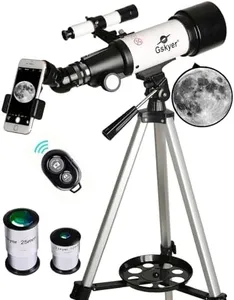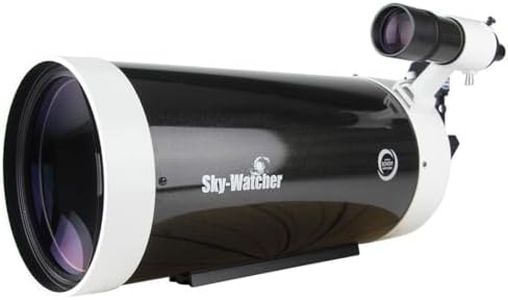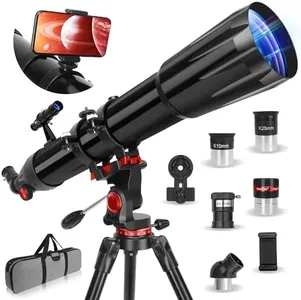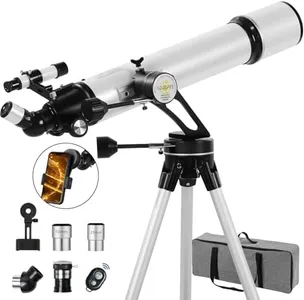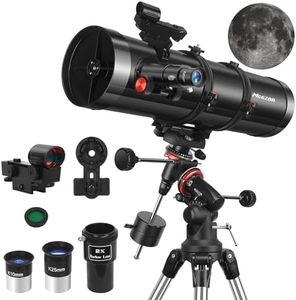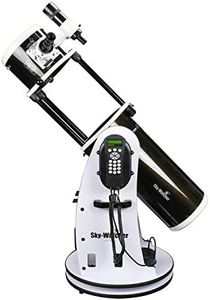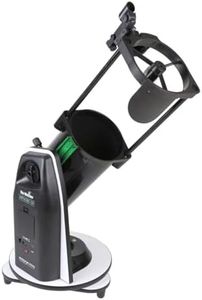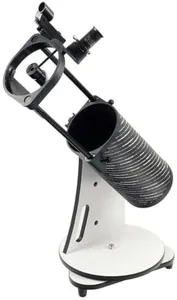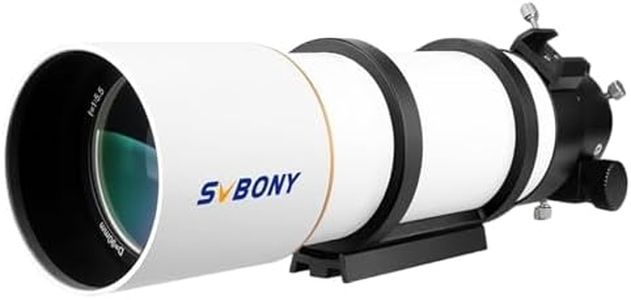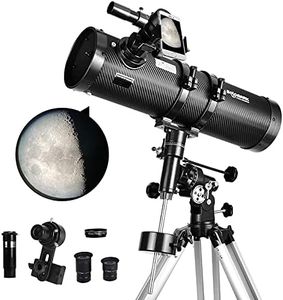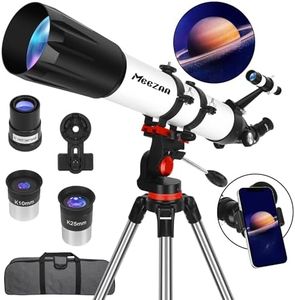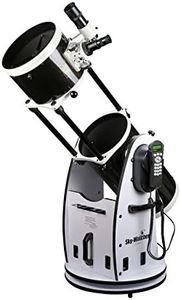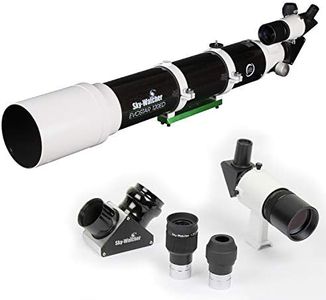10 Best Telescopes 2025 in the United States
Our technology thoroughly searches through the online shopping world, reviewing hundreds of sites. We then process and analyze this information, updating in real-time to bring you the latest top-rated products. This way, you always get the best and most current options available.

Our Top Picks
Winner
Gskyer Telescope, 70mm Aperture 400mm AZ Mount Astronomical Refracting Telescope for Kids Beginners - Travel Telescope with Carry Bag, Phone Adapter and Wireless Remote.
Most important from
21645 reviews
The Gskyer Telescope is an excellent choice for kids and beginners who are interested in exploring astronomy. With a 70mm aperture and 400mm focal length, it provides clear and bright images of the moon and stars. The fully coated optics ensure high transmission of light, enhancing image quality and protecting your eyes. The included 3x Barlow lens and two eyepieces offer versatile magnification options, making it easier to locate and observe celestial objects using the 5x24 finder scope. The Altazimuth mount allows smooth and simple movement, making it user-friendly for beginners.
The adjustable aluminum tripod and carry bag enhance its portability, allowing you to take it on your travels conveniently. The added smartphone adapter and wireless camera remote are great for capturing and sharing your celestial discoveries. While this telescope is highly rated and popular, its manual focus might require some practice to get right, and it’s designed mainly for casual star-gazing rather than advanced astronomical research.
Nonetheless, for its price point and ease of use, it's a solid entry-level telescope for those starting their journey into astronomy.
Most important from
21645 reviews
Sky-Watcher Skymax 180mm Maksutov-Cassegrain - Large Aperture Compound-Style Reflector Telescope (S11540)
Most important from
179 reviews
The Sky-Watcher Skymax 180mm Maksutov-Cassegrain is a strong choice for amateur astronomers who want clear and detailed views of the night sky, especially for planets and the moon. Its 180mm aperture (the size of the main lens/mirror) is large enough to capture good light, making images bright and sharp. The Maksutov-Cassegrain design combines mirrors and lenses to reduce distortions, and the telescope’s mirrors have a high 94% reflectivity coating, which helps in delivering crisp and contrast-rich views.
The telescope comes with a 28mm eyepiece and a 2-inch diagonal, providing comfortable viewing angles, and a 9x50 finderscope that helps in locating objects easily. It uses an altazimuth mount, which means it moves up/down and left/right, making it simpler to point than more complicated mounts but less suited for tracking fast-moving objects over time. Portability is decent given its size and weight of 19 pounds, so it’s manageable for transportation but not something you’d casually carry on long hikes. The optical tube length is relatively compact at 180mm, which is typical for Maksutov-Cassegrain models, helping with portability and storage.
The auto-focus feature simplifies getting sharp images without manual adjustments, making it user-friendly. It lacks motorized tracking, meaning you’ll need to manually adjust the telescope to follow celestial objects as they move. This telescope is best for someone interested in detailed views of the moon, planets, and some brighter deep-sky objects. It may not be the top pick for wide-field sky viewing or astrophotography beginners needing motorized mounts. However, if you want solid optical quality in a reasonably portable package and don't mind manual adjustments, the Skymax 180mm offers excellent value.
Most important from
179 reviews
Telescope 150EQ Astronomical Reflector Telescopes for Adults,Professional Manual Equatorial Telescope for Beginners.Comes with 2X Barlow Lens Phone Adapter,Stainless Tripod and Moon Filter
Most important from
194 reviews
The Dianfan 150EQ Astronomical Reflector Telescope offers a substantial 150mm aperture, which is excellent for capturing detailed images of celestial objects. Its 650mm focal length makes it quite versatile for both deep-sky and planetary observations. The inclusion of a 2x Barlow lens further enhances its magnification capabilities. Its German Equatorial Mount is a significant feature, providing precise tracking of celestial objects, which is great for those wanting to take their stargazing to the next level. This mount is pre-assembled, which simplifies setup for beginners.
The telescope comes fully equipped with two quality eyepieces, a phone adapter, a moon filter, and a red dot finderscope, making it user-friendly and ready for immediate use. The stainless steel tripod ensures a stable and durable foundation, adding to the ease of use for both novice and experienced stargazers. However, at 33 pounds, it is relatively heavy, which might make transportation challenging for some users. Additionally, as a manual focus telescope, it requires some learning and adjustment, particularly for beginners.
Despite these minor drawbacks, this telescope is a strong contender for both adults and kids who are serious about astronomy. The combination of quality optics, stable mounting, and comprehensive accessories make it suitable for a wide range of users, from beginners to more experienced astronomers.
